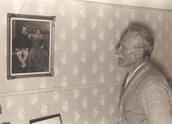
Jack Luscombe (1953)
Synopsis
In the 1950s, folk enthusiast John Meredith travelled around New South Wales recording songs for posterity. Jack Luscombe, 81 at the time, was the first singer Meredith recorded, providing a fascinating glimpse back in time. Meredith captured him singing songs about the shearers’ strikes of the 1890s, unionism and the Kelly Gang.
Curator’s notes
From 1953, John Meredith, a young pharmacist and accordion player living in Sydney, spent five years seeking out folk singers and dance musicians and recording them, firstly around Sydney and then through the central west of New South Wales. The songs and dance tunes he collected have become the basis of the revival of uniquely Australian folk songs and dance music, and Meredith’s work in the field has encouraged a second and third generation of folklore collectors to continue his work.
Jack Luscombe was recorded at his home in Ryde, Sydney, in July 1953. The 81-year-old had started work picking up wool in Queensland shearing sheds at age 11 in 1884, and was shearing four years later. The 28-minute interview includes fascinating reminiscences of the Shearers’ Strike of 1891, a period fundamental to the development of Australian democracy. It also features several songs including the first fragmentary version of ‘The Ryebuck Shearer’, a mainstay of bush bands ever since, and ‘Sam Griffiths’ (clip one).
In the 1950s in Sydney, cultural activities around folk music were mostly encouraged by various offshoots of the Communist Party such as the People’s Chorus choir. Meredith was a member of this group who sang folk songs from around the world, but few Australian ones. Although there had been several books published of the texts of Australian folk songs, starting off with ‘Banjo’ Paterson’s Old Bush Songs half a century earlier, it was generally accepted that no-one sang these songs any more, and that the melodies were lost.
Meredith and a few of his friends, however, were not convinced. By chance, another member of the choir met an elderly gentleman, Jack ‘Hoop-iron’ Lee, who knew several old bush songs and Meredith and Chris Kempster spent an afternoon frustratingly trying to write down the tunes of the songs. A neighbour of Meredith’s had a tape recorder, then a relatively new technology in Australia, with which Meredith was able to record the old man’s repertoire. He was determined to buy his own tape recorder, which at the time cost over £150 ($300). As Meredith was only earning £6 pounds ($12) a week, this was a significant investment.
In 1961, Meredith sold the 30 tapes to the National Library, becoming TRC4 (Tape Recording Collection 4) of the Oral History Section, but better known to the folk music community as the ‘Merro Collection’. Meredith and Hugh Anderson published the songs and stories about the performers in Folk Songs of Australia – and the Men and Women Who Sang Them in 1968. The tapes contain over 1,200 items – including uniquely Australian songs about shearing and droving as well as local variants of English, Scottish and Irish songs. They are all available to be heard on the National Library of Australia website.
The folklore films of John Meredith, including The Dawsons of Swamp Rd, Franklin, Tasmania, The Man from Cookamidgera: Songs and Music of Colin Charleton (1990) and The Bobbins of Nulliga are available for viewing on NFSA’s YouTube Channel.
- Overview
- Curator’s notes
- Audio 1 clip
- Principal credits
- Find a copy
- Make a comment
- Map
- Extras
- Add your review



